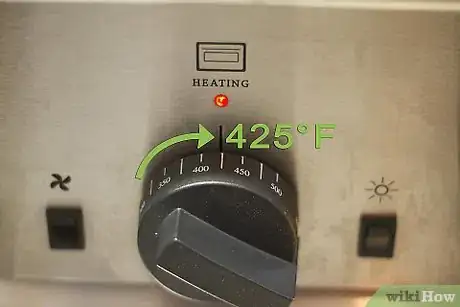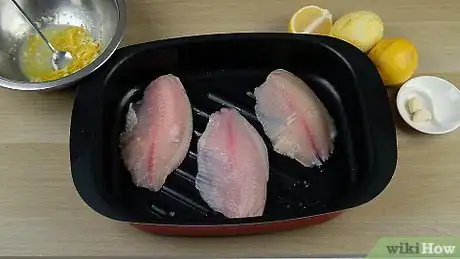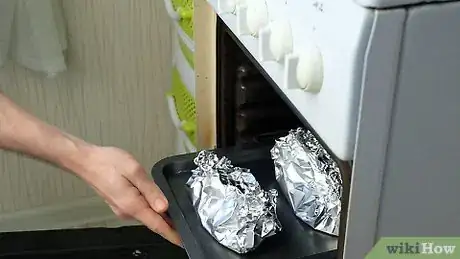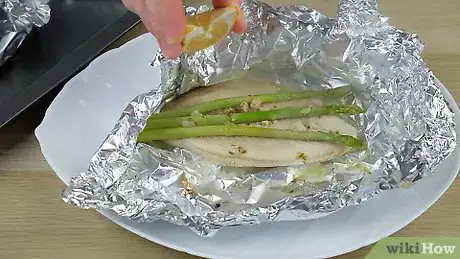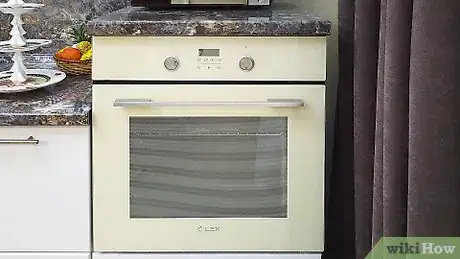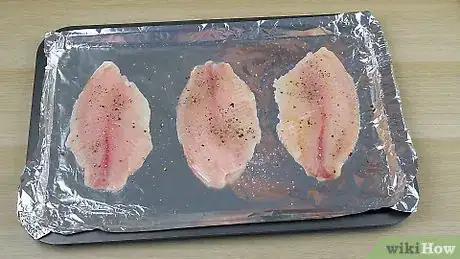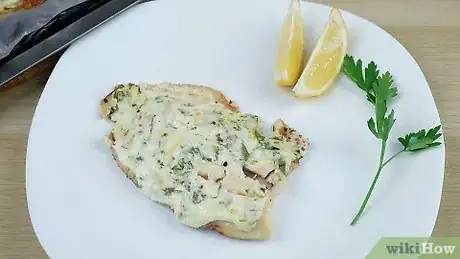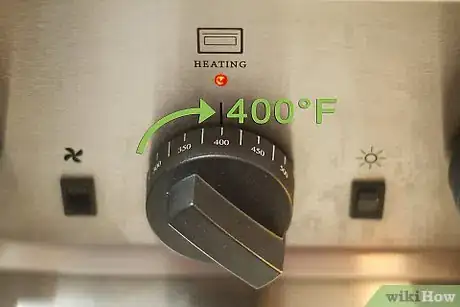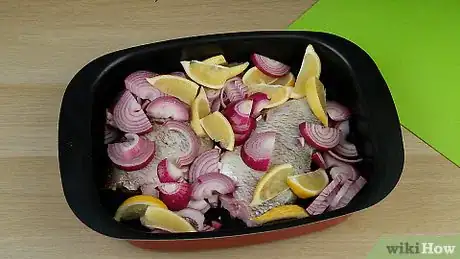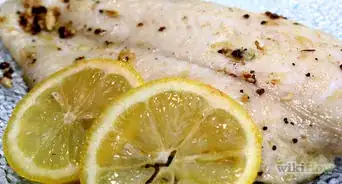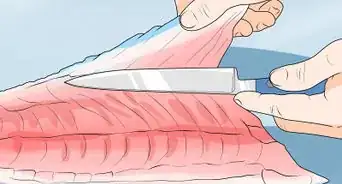This article was co-authored by wikiHow staff writer, Hunter Rising. Hunter Rising is a wikiHow Staff Writer based in Los Angeles. He has more than three years of experience writing for and working with wikiHow. Hunter holds a BFA in Entertainment Design from the University of Wisconsin - Stout and a Minor in English Writing.
There are 12 references cited in this article, which can be found at the bottom of the page.
The wikiHow Video Team also followed the article's instructions and verified that they work.
This article has been viewed 2,155,433 times.
Learn more...
Tilapia is a common white fish that absorbs flavors well when you cook with it. While you can always make tilapia in a pan, you can also bake it in your oven to fully infuse the flavors of other spices. You can either make tilapia filets in a baking pan or use foil wraps to speed up cooking times. You may also try baking the whole fish and stuff it with aromatics to have a more flavorful meal.
Ingredients
- 4 tilapia filets
- 2 tablespoons (30 ml) of melted butter
- 3 cloves of garlic
- 2 tablespoons (30 ml) of lemon juice
- Zest from 1 lemon
- Salt and pepper
Makes 4 servings
- 2 tilapia filets
- 6-8 sprigs of asparagus
- 2 tablespoons (30 ml) of melted butter
- 2 cloves of garlic
- 1 tablespoon (15 ml) of lemon juice
- 1 teaspoon (1 g) of dried oregano or thyme
- 1 fresh lemon
- Salt and pepper
Makes 2 servings
- 3 tilapia filets
- 1⁄4 cup (59 ml) of mayonnaise
- 2 tablespoons (7.5 g) of fresh parsley
- 1 teaspoon (2 g) of lemon zest
- Salt and pepper
Makes 3 servings
- 2 cleaned whole tilapia
- 1 pound (450 g) of red onions
- 2 fresh lemons
- 1 tablespoon (15 ml) of olive oil
- 3 tablespoons (3 g) of fresh cilantro
- 2 cloves of garlic
Makes 2-4 servings
Steps
Lemon Garlic Tilapia Filets
-
1Preheat your oven to 425 °F (218 °C). Make sure one of the oven racks in the center position so your tilapia can cook evenly. Turn your oven on and let it preheat completely before putting your fish in to cook.[1]
- You can also use a toaster oven to make single portions if you want.
-
2Whisk together melted butter, garlic, lemon juice, and lemon zest in a bowl. Pour 2 tablespoons (30 ml) of melted butter and 2 tablespoons (30 ml) of lemon juice into a mixing bowl and stir them together. Mince 2 cloves of garlic with a chef’s knife and add it to the butter and lemon juice. Use a zester or a grater to scrape the zest off of 1 lemon, and mix it into your butter mixture. Mix the ingredients until they’re thoroughly combined.[2]
- You can adjust how many spices and herbs you put in the mixture to change the flavor.
- If you want to add a little spice to your tilapia, add ½ teaspoon (1.5 g) of red chili powder into the butter mixture.[3]
Advertisement -
3Put your tilapia filets in an oiled cooking pan. Put a layer of non-stick cooking spray on a 13 in × 9 in (33 cm × 23 cm) baking pan so the tilapia doesn’t get stuck on the pan. Lay the filets down on the cooking pan so they have about 1 inch (2.5 cm) of space between them.[4]
- Thaw frozen tilapia completely before cooking with it, or else it may not get an even bake.
- Line your cooking pan with aluminum foil if you want an easy cleanup later.
-
4Drizzle the butter mixture over the filets to coat them. Slowly pour the butter mixture over the filets, letting any extra fill the bottom of the pan. Use a kitchen brush to spread the butter mixture evenly across the filets so they can absorb the most flavor while they’re cooking.[5]
- You can also top the tilapia with lemon slices if you want the filets to taste more citrusy.
Tip: If you want crispy breaded tilapia, coat the filets in toasted bread crumbs before you put them in the oven.[6]
-
5Put the tilapia in your oven for 10-12 minutes. Set the baking pan on the center rack of your oven so the filets get an even cook. Leave the oven door closed while the fish cooks or else some of the heat will escape. Check your fish after 10 minutes to see if it’s white and flaky. Remove the tilapia from the oven once it’s finished.[7]
- Make sure your tilapia cooks until it has an internal temperature of 145 °F (63 °C). Otherwise, you may get sick from foodborne bacteria.[8]
-
6Serve the tilapia while it’s still hot. Immediately serve the tilapia after it comes out of your oven so you can enjoy it while it’s still warm. Eat your fish with sides of fresh vegetables to have a healthy meal. Squeeze a fresh lemon wedge over the fish if you want to add more citrus flavor to it.[9]
- You can store leftovers in your fridge for up to 4 days or in the freezer for up to 3 months.[10]
Foil Pack Tilapia Filets with Vegetables
-
1Preheat your oven to 450 °F (232 °C). Move the racks inside your oven so one of them is in the center position, or else your fish won’t cook as thoroughly. Turn your oven on to 450 °F (232 °C) and let it heat up completely before cooking.[11]
-
2Combine melted butter, garlic, lemon juice, and oregano in a bowl. Pour 2 tablespoons (30 ml) of melted butter and 1 tablespoon (15 ml) of lemon juice into a mixing bowl and stir it with a whisk. Chop 2 cloves of garlic with a chef’s knife into small pieces and add them to the butter mixture. Then put in 1 teaspoon (1 g) of either oregano or thyme and combine the mixture thoroughly.[12]
- You can use a mixture of oregano and thyme if you want to use both herbs.
-
3Put the tilapia filets on separate pieces of aluminum foil with asparagus. Rip off a large piece of aluminum foil for each filet you’re cooking. Set the filet in the center of the aluminum foil along with 3-4 sprigs of asparagus next to it. Bend the sides of the aluminum foil up to form walls.[13]
- You can also include slices of zucchini or broccoli in the aluminum foil if you want more vegetables.
- Make sure your tilapia is completely thawed if it was frozen.
-
4Pour the butter mixture over your filets and vegetables. Carefully split the butter mixture between each of the filets and spread it with a kitchen brush. Make sure the tilapia and asparagus are completely coated in the butter mixture so the flavor can absorb into the meat.[14]
- Don’t bend the sides of the foil down or else the butter mixture will spill and won’t infuse with the fish.
-
5Wrap the foil around the fish so there’s a small opening on top. Bend the sides of the foil on top of the fish and asparagus so they’re completely covered. Leave a small opening in the foil on top so steam can vent out while the fish cooks.[15]
Tip: If the piece of foil you’re using wasn’t large enough to cover the fish, place another piece of foil on top and crimp the edges to seal the pieces together.
-
6Place the wrapped filets on the middle rack of your oven for 15-20 minutes. Place the foil directly on the center oven rack or on a cooking pan so it can cook. Leave the fish alone inside of the oven for at least 15 minutes before checking if it’s done. Check if the meat is white and flaky, and use a meat thermometer to see if it has an internal temperature of 145 °F (63 °C).[16]
- The cooking time may vary depending on the size and thickness of your filets.
-
7Serve the fish with fresh lemon while it’s still hot. Once the fish is finished cooking, put the foil wrap directly on a serving plate so you can open it just before you eat. Squeeze a fresh lemon wedge on top of the filet to add a fresh citrus flavor to your meal.[17]
- You can keep tilapia leftovers for 4 days in the fridge or up to 3 months in the freezer.
Broiled Tilapia with Lemon Mayonnaise
-
1Preheat your oven to broil. The broil setting on your oven will make your fish taste like it’s been made on the grill. Turn your oven to broil and let it heat up completely before cooking. Make sure one of the cooking racks is in the middle position inside your oven.[18]
- Not every oven will have a broil setting.
-
2Combine mayonnaise, parsley, and lemon zest in a bowl. Pour 1⁄4 cup (59 ml) of mayonnaise and 2 tablespoons (7.5 g) of fresh parsley into a mixing bowl, and stir them together. Use a zester or fork to scrape the zest off of a fresh lemon until you have 1 teaspoon (2 g). Use a whisk to thoroughly combine the herbs with the mayonnaise.[19]
- You can also add 2 cloves of minced garlic to infuse your fish with more aromatic flavors.
-
3Put your tilapia on a lined baking tray with salt and pepper. Line a baking sheet with aluminum foil so the fish doesn’t stick to the bottom. Spread your filets evenly across the pan so they have about 1 inch (2.5 cm) between them. Sprinkle a pinch of salt and pepper on top of each filet.[20]
- If you don’t line your baking tray, spread a non-stick cooking spray on the bottom to prevent the fish from sticking.
-
4Spread the mayonnaise mixture over the filets. Use a spoon or a rubber spatula to scoop equal amounts of the mayonnaise mixture onto each of your filets. Spread the mayonnaise so it completely covers the tops of the filets.[21]
- You can use as much or as little mayonnaise mixture as you want.
-
5Broil the fish for about 8 minutes until it flakes easily. Set the baking tray on the center rack of your oven and let it cook uncovered. After 8 minutes, check the internal temperature with a meat thermometer to make sure it’s over 145 °F (63 °C). Take the fish out of the oven once it reaches temperature and when the meat is white and flaky.[22]
Tip: Avoid opening your oven as much as you can while the fish is cooking or else some of the heat will escape.
-
6Serve the tilapia with fresh lemon wedges. Transfer the fish while it’s still hot onto a warm serving plate so it’s ready to eat. Provide a wedge of fresh lemon with each filet so you can squeeze some of the juice on top of the fish if you want.[23]
- Store leftovers in the fridge for up to 4 days or in the freezer for 3 months.
Whole Baked Tilapia
-
1Preheat your oven to 400 °F (204 °C). Move one of the oven racks into the center position so your fish can cook thoroughly. Turn the oven onto 400 °F (204 °C) and let it preheat completely or else the fish won’t have an even cook.[24]
-
2Rinse your tilapia and pat it dry. Hold your fish under clean running water to rinse out any residual blood or waste inside of it. Rub the meat while you’re cleaning it to clean it completely. Once you’re finished rinsing it, use paper towels to pat the fish dry again.[25]
- You can buy whole fresh tilapia from the seafood section of your local supermarket. You may also be able to get whole tilapia frozen.
-
3Brush the fish’s skin with olive oil. Dip the bristles of a kitchen brush into 1 tablespoon (15 ml) of olive oil and lightly coat the outside of the fish. Make sure to brush the entire fish with the oil so flavors can infuse easier and so it doesn’t stick to the baking pan.[26]
- You can use any type of vegetable oil for your fish if you don’t have olive oil.
- Hold the fish over your baking pan while you brush on the oil so you don’t spill it.
-
4Place the fish in a baking tray with sliced lemons and red onions. Lay the fish flat on its side on the baking pan. If you’re making multiple fish, then leave about 1–2 inches (2.5–5.1 cm) between them so you have space to add aromatics. Fill in the space around the fish with sliced lemons and red onion so they can cook down and infuse flavors into the meat.[27]
- You don’t need to use lemon and onion if you don’t want to, but it can add a lot of flavor to the dish.
-
5Stuff the inside of the fish with onions, lemon, cilantro, and garlic. Lift open the bottom of your tilapia so you can stuff aromatics inside it. Put 5-6 onion slices, 2 slices of fresh lemon, 1 ½ tablespoon (1.5 g) of fresh cilantro, and a clove of fresh garlic inside each fish. Close the fish so you don’t lose any flavor..[28]
- You can stuff the fish with whatever herbs and spices you want. Try oregano, thyme, or dill for additional flavors.
-
6Bake the fish uncovered for 15-20 minutes. Put the baking pan in your oven on the center rack, and leave it alone for at least 15 minutes. Check the internal temperature of the fish with a meat thermometer to make sure it’s at or above 145 °F (63 °C), or else it’s not safe to eat. Remove the fish from the oven once it’s done cooking and the meat flakes apart easily.[29]
- The cooking time for each fish will vary depending on its size and thickness.
-
7Serve the tilapia whole while it’s still hot. Transfer one of the tilapia along with some of the cooked onions onto a serving plate with a fresh wedge of lemon. You can eat the skin and the meat of the tilapia.[30]
- Keep leftovers in the fridge for up to 4 days and in the freezer for up to 3 months.
Warning: Watch out for pin bones in the fish. They can be sharp and will hurt you if you chew on or swallow them.
Community Q&A
-
QuestionWhat is the nutritional value of Tilapia?
 Community AnswerProtein 21g; Fat 0g; Carbs 0g; Tilapia is great for getting needed protein.
Community AnswerProtein 21g; Fat 0g; Carbs 0g; Tilapia is great for getting needed protein. -
QuestionWhat are good side dishes to go with tilapia fillets?
 5655555657h76hCommunity AnswerVegetables and rice.
5655555657h76hCommunity AnswerVegetables and rice. -
QuestionWhat is the baking time for tilapia?
 Community AnswerYou should bake it until it is flaky and the internal temperature is at least 145 degrees. The time is dependent on the thickness, but probably around 15-20 minutes or so.
Community AnswerYou should bake it until it is flaky and the internal temperature is at least 145 degrees. The time is dependent on the thickness, but probably around 15-20 minutes or so.
Warnings
- Make sure you cook fish so it has an internal temperature of 145 °F (63 °C) or else it could be unsafe to eat.[31]⧼thumbs_response⧽
- Be cautious of pin bones while you’re eating whole tilapia since they are sharp and could hurt you if you swallow them.⧼thumbs_response⧽
Things You’ll Need
Lemon Garlic Tilapia Filets
- Oven
- Bowl
- Whisk
- Chef’s knife
- Zester
- Cooking pan
- Non-stick cooking spray
- Serving plate
Foil Pack Tilapia Filets
- Oven
- Mixing bowl
- Whisk
- Chef’s knife
- Aluminum foil
- Serving plate
Broiled Tilapia with Lemon Mayonnaise
- Oven
- Mixing bowl
- Whisk
- Baking tray
- Aluminum foil
- Spoon or rubber spatula
- Serving plate
Whole Baked Tilapia
- Oven
- Sink
- Paper towel
- Kitchen brush
- Baking tray
- Chef’s knife
- Serving plate
References
- ↑ https://www.eatingonadime.com/easy-baked-tilapia-recipe/
- ↑ https://damndelicious.net/2016/04/30/baked-lemon-butter-tilapia/
- ↑ https://www.whiskaffair.com/spicy-lemon-garlic-baked-tilapia-recipe/
- ↑ https://damndelicious.net/2016/04/30/baked-lemon-butter-tilapia/
- ↑ https://damndelicious.net/2016/04/30/baked-lemon-butter-tilapia/
- ↑ https://www.foodandwine.com/recipes/crispy-baked-tilapia
- ↑ https://damndelicious.net/2016/04/30/baked-lemon-butter-tilapia/
- ↑ https://www.fsis.usda.gov/wps/portal/fsis/topics/food-safety-education/get-answers/food-safety-fact-sheets/safe-food-handling/safe-minimum-internal-temperature-chart/ct_index
- ↑ https://www.whiskaffair.com/spicy-lemon-garlic-baked-tilapia-recipe/
- ↑ https://stilltasty.com/fooditems/index/18502
- ↑ https://bestrecipebox.com/foil-pack-white-fish/
- ↑ https://bestrecipebox.com/foil-pack-white-fish/
- ↑ https://bestrecipebox.com/foil-pack-white-fish/
- ↑ https://bestrecipebox.com/foil-pack-white-fish/
- ↑ https://thenoshery.com/herbed-tilapia-foil-packets/
- ↑ https://bestrecipebox.com/foil-pack-white-fish/
- ↑ https://bestrecipebox.com/foil-pack-white-fish/
- ↑ https://www.findingzest.com/broiled-tilapia/
- ↑ https://www.findingzest.com/broiled-tilapia/
- ↑ https://www.skinnytaste.com/broiled-garlic-tilapia/
- ↑ https://www.findingzest.com/broiled-tilapia/
- ↑ https://www.skinnytaste.com/broiled-garlic-tilapia/
- ↑ https://www.skinnytaste.com/broiled-garlic-tilapia/
- ↑ https://www.food.com/recipe/whole-baked-tilapia-177687
- ↑ https://eatingrichly.com/how-to-cook-a-whole-fish/
- ↑ https://www.food.com/recipe/whole-baked-tilapia-177687
- ↑ https://www.food.com/recipe/whole-baked-tilapia-177687
- ↑ https://www.food.com/recipe/whole-baked-tilapia-177687
- ↑ https://eatingrichly.com/how-to-cook-a-whole-fish/
- ↑ https://www.food.com/recipe/whole-baked-tilapia-177687
- ↑ https://www.fsis.usda.gov/wps/portal/fsis/topics/food-safety-education/get-answers/food-safety-fact-sheets/safe-food-handling/safe-minimum-internal-temperature-chart/ct_index
About This Article
Before cooking tilapia in the oven, preheat the oven to 400° F, coat the filets in melted butter, and wrap them individually in aluminum foil. Then, place the wrapped fish in a shallow baking dish and cook them for 20 minutes. If you don’t want to use aluminum foil, preheat the oven to 375° F and cook the tilapia filets for 20-30 minutes, or until they flake easily with a fork. Scroll down to learn how to broil tilapia, and for tasty seasoning tips!
